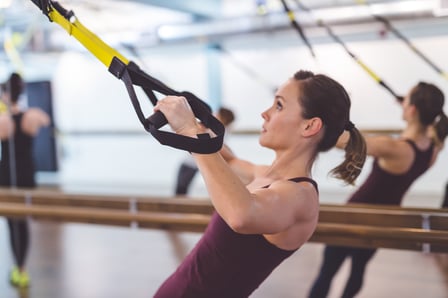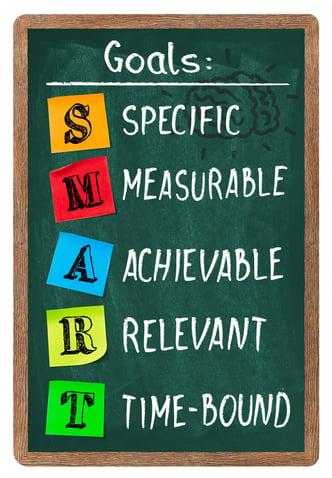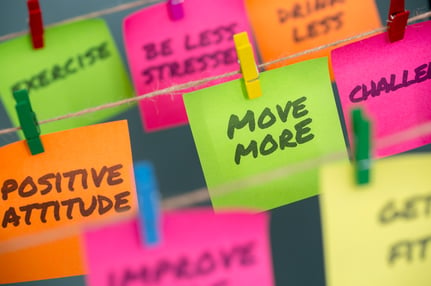 As we ring in the New Year, many are thinking about what they want out of 2026 and are forming new goals and resolutions. According to Forbes, a whopping 48% of those goals are fitness related, with another 34% making weight loss resolutions and 32% making dietary resolutions. Looking at the stats, it’s clear that people have a vested interest in their health and are conscious of needed improvements. On average, 80% of New Year’s resolutions are abandoned by February and only 9-20% achieve their goal by the end of the year. This is such a prevalent issue that the second Friday in January is called “Quitter’s Day”. To overcome this, let’s be smart this year. Instead of making vague and unrealistic goals, I’m going to tell you how to make SMART goals!
As we ring in the New Year, many are thinking about what they want out of 2026 and are forming new goals and resolutions. According to Forbes, a whopping 48% of those goals are fitness related, with another 34% making weight loss resolutions and 32% making dietary resolutions. Looking at the stats, it’s clear that people have a vested interest in their health and are conscious of needed improvements. On average, 80% of New Year’s resolutions are abandoned by February and only 9-20% achieve their goal by the end of the year. This is such a prevalent issue that the second Friday in January is called “Quitter’s Day”. To overcome this, let’s be smart this year. Instead of making vague and unrealistic goals, I’m going to tell you how to make SMART goals!
SMART Goals Explained
SMART is an acronym used to guide your goal setting, and it stands for the following:
Specific – be as detailed as possible. If you don’t set up a goal post, how will you ever know if you reached your goal? For example, instead of saying “I want to eat healthier this year” you could say “I want to eat healthier this year by eating 3-5 servings of fruits and vegetables a day.” That way you’re setting parameters that you’re aware of and know what direction to go with your healthy eating
Measured – make it trackable. You should be able to track your progress on your way to your goal, so you know how close you are to completing it. A good way to make your goal easy to measure is by making it quantifiable. That way you just have a number to work towards, letting you know where you are on your journey. A good example would be “I want to add 20lbs to my bench max” instead of “I want to get stronger.”
Achievable – set a realistic goal. There’s nothing wrong with being confident when setting your goals, as long as you’re REASONABLY confident! For example, if you were to set a goal like “I want to lose 50lbs by the end of this week!!!” you would be setting yourself up for failure or disappointment. Sometimes setting smaller goals leading to your main goal can help! “I want to lose 3lbs this month” this can help you reach that larger weight loss goal by the end of the year.
Relevant – as in salient. The work you’re doing should contribute towards whatever goal you set for yourself. While that may seem obvious, it’s easy to find yourself having pushed hard in the wrong direction if you don’t do the necessary research. For example, if you set a goal of
making advancements in your fitness career, and you start studying for the Bar Exam, you will not have made any progress.
Time-Bound – set a deadline. While deadlines usually induce stress, by giving yourself a time limit you’ll be more urgent in chasing your goals! It's easy to fall victim to procrastination when you have no clear time to start, but by setting a time limit and lighting a fire you’ll be much more likely to start sooner rather than later!
Now that you’re SMARTer…
Be sure to use these tips this new year when setting your goals. Let this year be the year that you carry out everything you set out to. And of course, if you have any questions or need any help setting SMART goals, come schedule an Exercise Prescription for free at the Fitness Center Desk! Have a wonderful 2026!

 Setting a routine requires a blend of creativity, discipline, and intentional planning. A healthy routine aligns with your long-term goals and fosters self-fulfillment. To build a lasting routine, start by envisioning your happiest and most successful self. What does your ideal day look like? How do you feel? Who are you with? Visualizing this future can provide clarity and inspire you to take action.
Setting a routine requires a blend of creativity, discipline, and intentional planning. A healthy routine aligns with your long-term goals and fosters self-fulfillment. To build a lasting routine, start by envisioning your happiest and most successful self. What does your ideal day look like? How do you feel? Who are you with? Visualizing this future can provide clarity and inspire you to take action.
 Have you ever started an exercise program and for whatever reason were not able to stick with it? There are many reasons that you may not be able to stick with an exercise program. It might be too hard, and you are not able to maintain the amount of work that is required. Maybe your workouts take too much time, and you are not able to fit it into your schedule. Or maybe you are not seeing the results you want. Whatever the reason that you were not able to find sustainability within your exercise program, there is always a solution. The best way I have found to find sustainability in exercise is to figure out your goals, then pick your programming, and lastly find consistency in your exercise.
Have you ever started an exercise program and for whatever reason were not able to stick with it? There are many reasons that you may not be able to stick with an exercise program. It might be too hard, and you are not able to maintain the amount of work that is required. Maybe your workouts take too much time, and you are not able to fit it into your schedule. Or maybe you are not seeing the results you want. Whatever the reason that you were not able to find sustainability within your exercise program, there is always a solution. The best way I have found to find sustainability in exercise is to figure out your goals, then pick your programming, and lastly find consistency in your exercise. 
 Think about some top goals you have. Maybe your top goal is to
Think about some top goals you have. Maybe your top goal is to 
 Where did this year go? Whether it was the best year of your life, or you’re looking forward to a fresh start in the new year, you may likely have some health and fitness goals at the top of your list of resolutions. How do you make sure they aren’t just a pipe dream? Let’s find out!
Where did this year go? Whether it was the best year of your life, or you’re looking forward to a fresh start in the new year, you may likely have some health and fitness goals at the top of your list of resolutions. How do you make sure they aren’t just a pipe dream? Let’s find out!
 Having something come up that changes your routine or throws off your groove can be frustrating or disheartening because, let’s be honest, we all have things that we want to do. Looking at this from an athlete’s point of view is a little different than that of the general public.
Having something come up that changes your routine or throws off your groove can be frustrating or disheartening because, let’s be honest, we all have things that we want to do. Looking at this from an athlete’s point of view is a little different than that of the general public.